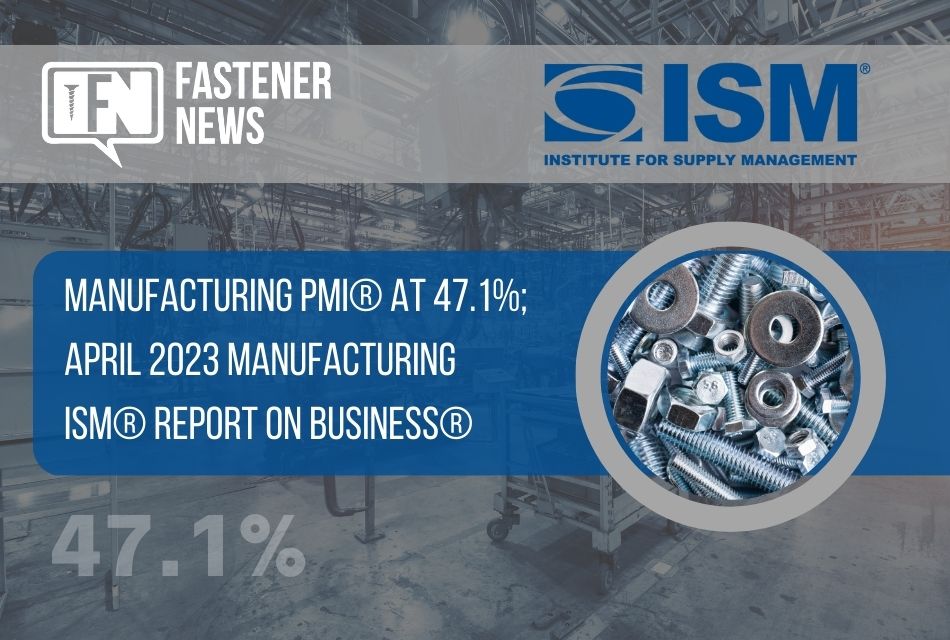Manufacturing PMI® at 47.1%; April 2023 Manufacturing ISM® Report On Business®

NEWS PROVIDED BY: Institute for Supply Management
May 01, 2023
New Orders and Production Contracting; Backlogs Contracting; Supplier Deliveries Faster; Raw Materials Inventories Contracting; Customers’ Inventories Too High; Prices Increasing; Exports and Imports Contracting
, /PRNewswire/ — Economic activity in the manufacturing sector contracted in April for the sixth consecutive month following a 28-month period of growth, say the nation’s supply executives in the latest Manufacturing ISM® Report On Business®.
The report was issued today by Timothy R. Fiore, CPSM, C.P.M., Chair of the Institute for Supply Management® (ISM®) Manufacturing Business Survey Committee:
“The April Manufacturing PMI® registered 47.1 percent, 0.8 percentage point higher than the 46.3 percent recorded in March. Regarding the overall economy, this figure indicates a fifth month of contraction after a 30-month period of expansion. The New Orders Index remained in contraction territory at 45.7 percent, 1.4 percentage points higher than the figure of 44.3 percent recorded in March. The Production Index reading of 48.9 percent is a 1.1-percentage point increase compared to March’s figure of 47.8 percent. The Prices Index registered 53.2 percent, up 4 percentage points compared to the March figure of 49.2 percent. The Backlog of Orders Index registered 43.1 percent, 0.8 percentage point lower than the March reading of 43.9 percent. The Employment Index elevated into expansion territory, registering 50.2 percent, up 3.3 percentage points from March’s reading of 46.9 percent. The Supplier Deliveries Index figure of 44.6 percent is 0.2 percentage point lower than the 44.8 percent recorded in March; this is the index’s lowest reading since March 2009 (43.2 percent). The Inventories Index dropped 1.2 percentage points to 46.3 percent, lower than the March reading of 47.5 percent. The New Export Orders Index reading of 49.8 percent is 2.2 percentage points higher than March’s figure of 47.6 percent. The Imports Index remained in contraction territory, though just barely, at 49.9 percent, 2 percentage points above the 47.9 percent reported in March.”
Fiore continues, “The U.S. manufacturing sector contracted again; however, the Manufacturing PMI® improved compared to the previous month, indicating slower contraction. The April composite index reading reflects companies continuing to manage outputs to better match demand for the first half of 2023 and prepare for growth in the late summer/early fall period. Demand eased again, with the (1) New Orders Index contracting, but at a slower rate, (2) New Export Orders Index slightly below 50 percent but improving, (3) Customers’ Inventories Index entering the low end of ‘too high’ territory, a negative for future production and (4) Backlog of Orders Index continuing in strong contraction. Output/Consumption (measured by the Production and Employment indexes) was positive, with a combined 4.4-percentage point upward impact on the Manufacturing PMI® calculation. The Employment Index indicated slight expansion after two months of contraction, and the Production Index logged a fifth month in contraction territory, though at a slightly slower rate. Panelists’ comments continue to indicate near equal levels of activity toward expanding and contracting head counts at their companies, amid mixed sentiment about when significant growth will return. Inputs — defined as supplier deliveries, inventories, prices and imports — continue to accommodate future demand growth. The Supplier Deliveries Index indicated faster deliveries, and the Inventories Index dropped further into contraction as panelists’ companies manage inventories exposure. The Prices Index moved back into ‘increasing’ territory, at a moderate level, after one month of marginally decreasing prices.
“Of the six biggest manufacturing industries, two — Petroleum & Coal Products; and Transportation Equipment — registered growth in April.
“New order rates remain sluggish as panelists remain concerned about when manufacturing growth will resume. Panelists’ comments registered a 1-to-1 ratio regarding optimism for future growth and continuing near-term demand declines. Supply chains are prepared and eager for growth, as panelists’ comments support reduced lead times for their more important purchases. Price instability remains and future demand is uncertain as companies continue to work down overdue deliveries and backlogs. Seventy-three percent of manufacturing gross domestic product (GDP) is contracting, up from 70 percent in March. However, fewer industries contracted strongly; the proportion of manufacturing GDP with a composite PMI® calculation at or below 45 percent — a good barometer of overall manufacturing weakness — was 12 percent in April, compared to 25 percent in March,” says Fiore.
The five manufacturing industries that reported growth in April are: Printing & Related Support Activities; Apparel, Leather & Allied Products; Petroleum & Coal Products; Fabricated Metal Products; and Transportation Equipment. The 11 industries reporting contraction in April, in the following order, are: Furniture & Related Products; Wood Products; Nonmetallic Mineral Products; Electrical Equipment, Appliances & Components; Plastics & Rubber Products; Chemical Products; Machinery; Primary Metals; Computer & Electronic Products; Food, Beverage & Tobacco Products; and Miscellaneous Manufacturing.
WHAT RESPONDENTS ARE SAYING
- “Having invested heavily to de-risk the supply chain over the last three years due to COVID-19, we are looking to reset with a number of our suppliers to reduce inventory, which has grown steadily over that period. Lead times are generally coming down, although electronic components are still a concern.” [Computer & Electronic Products]
- “Business continues to contract, albeit slowly year over year. We are burning existing inventory when possible and catching up on orders. Suppliers are shipping materials at a faster pace, especially to get the payable process started at the end of the first quarter. Employment is steady, with manpower decisions based on expected order flow in the second quarter, which is subject to change. Staffing levels in our sector are not decreasing, but employment openings are slowing across the economy, which reduces the pool of replacement candidates. We are currently projecting that the third quarter will see some improvement in business, especially in our metals coating for the aerospace industry. But unforeseen circumstances — international or domestic — could change things quickly.” [Chemical Products]
- “Pricing pressures continue to plague daily operations. After consecutive years of inflation and aggressive pricing to our retailers, we are starting to see resistance in the willingness to pass along pricing to end consumers. Discounting has entered into conversations.” [Food, Beverage & Tobacco Products]
- “Business is steady. Closely monitoring demand going forward to detect a negative trend.” [Transportation Equipment]
- “Customers seem to be quite heavy on inventory (as is my employer). This has made for a significant slowdown in sales orders for the last number of months.” [Machinery]
- “Faster deliveries and shorter lead times from suppliers. … Customers starting to talk build rate reductions for the second half of 2023.” [Fabricated Metal Products]
- “Business conditions remain strong, with sales and bookings exceeding plan. The backlog continues to grow due to increased bookings and supply chain constraints on electronic components.” [Miscellaneous Manufacturing]
- “Sales continue to be soft, similar to 2019 pre-COVID. Expect softness to last for as long as another two years.” [Electrical Equipment, Appliances & Components]
- “Business is picking up a bit in the automotive and construction industries — not on par with 2022 but beginning to look better.” [Plastics & Rubber Products]
- “We seem to be in a season of contradictions. Business is slowing, but in some ways, it isn’t. Prices for some commodities are stabilizing, but not for others. Some product shortages are over, others aren’t. Trucking is more plentiful, except when it isn’t. There’s uncertainty one day, but not the next. The next couple of months should provide answers — or not. It’s hard to make projections at the moment.” [Primary Metals]
RELATED CONTENT:
Manufacturing PMI® at 46.3%; March 2023 Manufacturing ISM® Report On Business®
Manufacturing PMI® at 47.7%; February 2023 Manufacturing ISM® Report On Business®
Fastener News, Fastener News Desk, Fastener News Podcast, Featured, Manufacturing, Supply Chain, Supply Chains













Leave a Reply